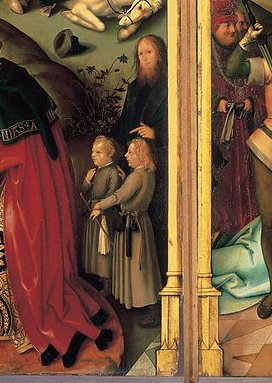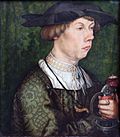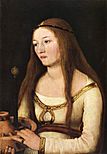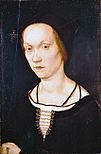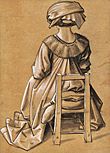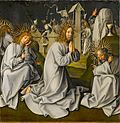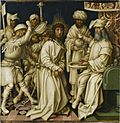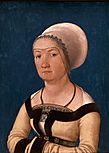Hans Holbein the Elder facts for kids
Quick facts for kids
Hans Holbein the Elder
|
|
|---|---|
| Hans Holbein der Ältere | |
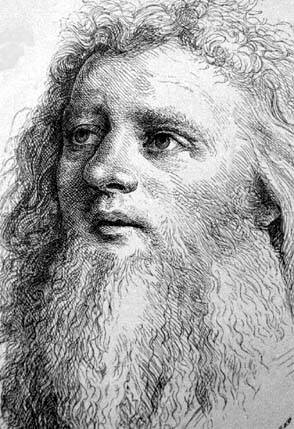 |
|
| Born |
Hans Holbein
c. 1460 Augsburg (free imperial city), Holy Roman Empire
|
| Died | 1524 (aged 63–64) |
| Movement | Late Gothic |
Hans Holbein the Elder (born around 1460 – died 1524) was a very important German painter. He is famous for his beautiful religious artworks. He also helped change German art from an older style called Late Gothic to the new Renaissance style.
Hans Holbein the Elder was part of a famous family of artists. His two sons, Ambrosius Holbein and Hans Holbein the Younger, also became well-known painters. They both learned their first painting lessons from their father.
Contents
Early Life and Family
Hans Holbein the Elder was born in a city called Augsburg in what is now Germany. He later passed away in Issenheim, which is now part of France. His father was Michael Holbein, and his brother, Sigmund Holbein, was also a painter.
We don't know the exact year Hans Holbein the Elder was born. However, we know he was working as an artist by 1493. That year, he created parts of a large altarpiece for an abbey in Weingarten. These artworks showed scenes like the birth of the Virgin Mary. Today, you can see these panels in the cathedral in Augsburg.
Artistic Style and Works
Holbein the Elder painted many colorful religious scenes. His later works show how he helped lead German art into the exciting new Renaissance style. This was a big change from the older Gothic art.
Besides his main altarpieces, he also designed beautiful church windows. He also created woodcuts, which are prints made from carved wood blocks. He even made many portrait drawings. These drawings were very detailed and showed the faces of people. They were a bit like the famous portraits his son, Hans Holbein the Younger, would later create.
Working in Augsburg
Holbein first worked in Augsburg with his brother, Sigmund. Augsburg was a busy city and a center for art during the time of Maximilian I, Holy Roman Emperor. Artists there were influenced by styles from places like Bruges and Brussels. Even though Augsburg was close to Italy and had trade links with Venice, it still had its own unique art style.
Hans was the main artist in the partnership with his brother. He signed all the artworks they produced together.
Later Years and Travels
Around 1514, Hans Holbein the Elder's sons left Augsburg. They both eventually settled in a city called Basel. After 1516, Holbein the Elder faced some financial difficulties in Augsburg. This meant he had to look for work in other places.
He had worked in Alsace before, in 1509, and still had connections there. In Issenheim, Alsace, he found new people who wanted to buy his art. He was hired to finish a large altarpiece there. However, he had some debts in Augsburg, and people were trying to get him to pay them back.
Because of these troubles, he left Issenheim and went to Basel. He left behind his work and equipment. He passed away two years later in an unknown place. After 1524, his name was no longer on the list of artists in Augsburg.
One of his famous works is the 1504 altarpiece called the Basilica of St. Paul. In the left part of this painting, Holbein the Elder included portraits of himself and his two sons.
Gallery
-
Christ on the Mount of Olives, part of his Grey Passion series
-
Pontius Pilate washing his hands
-
Resurrection, part of his Grey Passion series
See also
 In Spanish: Hans Holbein el Viejo para niños
In Spanish: Hans Holbein el Viejo para niños


